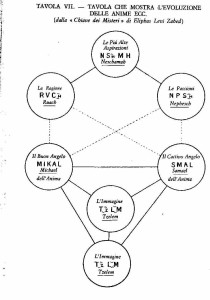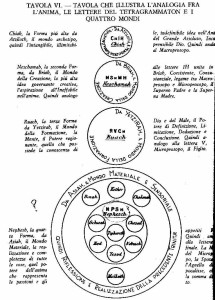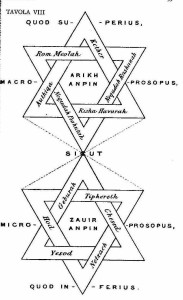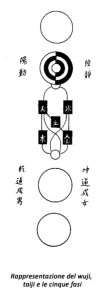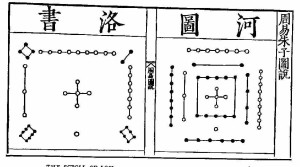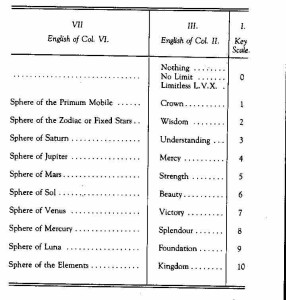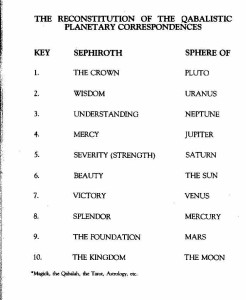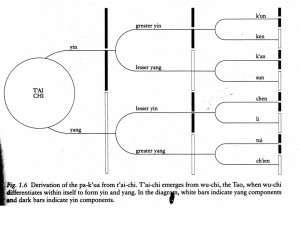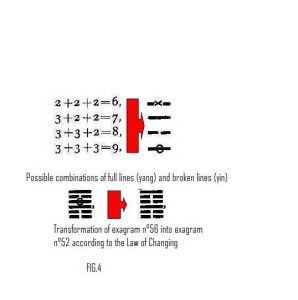Numerology and Classification: “The Book of Creation” and “The Canon of Changes” (Sefer Yezirah and Yi Jing)
Petrella F., ‘The Case and the Canon in Chinese and Jewish Numerological Traditions: analogies between the Yi Jing and the Sepher Yetzirah’. From: ‘The Case and the Canon: Anomalies, Discontinuities, Metaphors between Science and Literature, A. Calanchi et alia, Interfacing Science, Literature and the Humanities, ACUME 2, vol.7, 2011, V&R unipress GmbH.
Different kinds of numerology and classification (as symbolical and non-mathematical operations with numbers and geometrical structures) play extremely important role in various systems of the Jewish mystical tradition (i.e. Kabbalah).
There is one great cultural tradition in the world, which pays great attention to numerology, attention, which may be compared only with the Kabbalistic one: the Chinese tradition, partially based on the Canon ofChanges (Yijing) and partially on various cosmological and cosmogonical concepts of different origin
Therefore it is quite natural and desirable to try to compare these two (Jewish and Chinese) numerological traditions in their structural as well as ideological aspects.
A number of special researches is necessary to develop such an interesting comparison which can not be solved in this brief communication.
So, here I prefer to choose one only task: to compare some essentials of the Chinese cosmological classifications with the material of such an important text for the Kabbalistic tradition as Sefer Yezirah – The Book of Creation. Through this comparison the Case and the Canon theme will appear as a possible key of interpretation.
Sefer Yezirah has become one of the key terms of the Kabbalah, where it means the system of theophanies of the divine attributes of the transcendent apophatic Absolute – Ein-Sof (the Unlimited) which constitute the pleroma, the completion of divine life. But in Sefer Yezirah this term has, probably, the meaning of “number” or “cypher”. Nevertheless these Sefiroth are very mysterious: the author of the text, in describing them, uses the image of the Hayoth (“animals”) from the prophet Yehezqel (Ezechiel); this fact relates Sefer Yezirah with the Merkabah tradition, i.e. with that kind of early Jewish mysticism, which concentrates on the mystical Chariot of the Divine Being of the same prophet.
The text describes these ten Sefiroth as beli mah – literally: “nothing”, “without anything”, “Sefiroth of no-thing”; such a definition may be understood as pointing to the formal and paradigmatical character of these transcendental “numbers” in their function of the universal marks of the cosmological classificational rows. It is important, so, that these ten “Sefiroth of no-thing” together with 22 letters construct the structural foundation of all multiplicity of creation.
The central point of Sefer Yezirah is the interpretation of 32 primordial structure of existence as universal classificatory rows. Thus, Sefiroth correlate with the four elements of creation (Spirit of the God, ether, water and fire) and six world directions (including up and down). It may be said that Sefiroth not only designate or mark classificatory rows, but play the role of the first paradigmatic member of each row as well.
The same (and even in a greater degree) can be noted about «letters» of The Book of Creation. It is also important that every cosmogonic and cosmological process can be seen as linguistic by its intrinsic nature. This doctrine received its further development in classical Kabbalah where the process of the divine explication in the sefirothic worlds of pleroma can be understood as a process of the divine self-description by means of the transcendent «letters», i.e. – linguistic units of the divine Mind.
The author of Sefer Yezirahcompares division or classification of the letters according to their phonetic origin with the division of the creation in three spheres, establishing the corresponding correlation between them. These three spheres of creation are World (space or place – locus), Year (time) and Soul (nefesh; here – structure of the human body as microcosm).
All the creation has been «sealed» by the great sacred Name of Yaho – YHV, which is the abbreviated form of the great Tetragrammaton – YHVH, deciphered in contemporary academic works as Yahveh. According to the concluding passage of the text, Abraham obtained divine revelation due to the mystical contemplation of the Letters and Sefiroth. Because of this, the text is sometimes titled as «The letters of our Father Abraham».
The reading of Sefer Yezirah connected with Chinese studies constantly suggests some very clear associations owing to the rich Chinese lore of numerology and classificationism (xiang shu zhi xue, i.e. “the teaching about images and numbers”).
The numerologically meaningful basic numbers in China were 2 (the symbol of the “negative” – in cosmological, but not in ethical, sense – energy of yin) and 3 (the symbol of the “positive” energy of yang). The other symbolic numbers were the results of different combinations of these two main numbers. The most important of these secondary numbers was 5, which marked the universal system of classificatory rows known as «five elements» (wu xing).
These elements were connected with each other not substantially, but in functional way, being the first or the principal unit of their classificatory rows.
Let us look at the part of the classificatory row of the element “metal” (jin), taken by as example:
Metal – west – autumn – justice – white – Venus (planet) – lungs.
Here we have a row, which is marked by its first\main member, which establishes correspondence between the element, world direction, season, ethical quality, colour, planet, principal organ of the body (the row may be continued). One of the aspects of this classification is the establishing of the correspondences between homomorphic micro- and macrocosm.
Here we also (like in the Chinese cosmological row) can see the row marked by its first\main member (letter); this row establishes correspondences between letter, planet\ Zodiacal constellation, day of the week or month of a year and organ of the body. It can be seen that the letters of Sefer Yezirah (as well as Sefiroth) have the same function as the elements of the Chinese classificatory cosmological rows, i.e. they are codes of the rows as their first or main members.
It can be noted as well, that the rows of Sefer Yezirah establish correlation between the elements of micro- and macrocosm as their Chinese counterparts also do.
It must be said, that in Sefer Yezirah 22 letters have been divided into lesser groups; this gave the opportunity to establish two different classificatory sets of rows: one consisting of seven members (days of the week and planets – here we have 7 planets and not 5 as in the Chinese texts) and one consisting of twelve members (months of a year, Zodiacal constellations).
The Chinese counterparts of these two sets are (in formal aspect) calendar rows of ten «celestial branches» and twelve «earthly roots». It is rather important, that Chinese cyclical signs of these two rows are especially akin (in structural and functional sense) to the “Sefiroth of no-thing” of The Book of Creation.
Thus, we can observe a complete similarity between the Chinese and the Kabbalistic classificatory rows. It must be only added that because of the pictographic, symbolic and non-phonetic nature of the Chinese writing characters, Chinese basic classifiers because of their essence have more similarity not with the letters of the Hebrew text, but with the Sefiroth as they are treated in Sefer Yezirah (i.e. some primordial divine numbers).
Both the two systems (Sephiroth and exagrams) work as bridges between the macrocosm and microcosm and as mirrors of the interdependence between objective events and subjective conditions (psychic) of the observer.
This peculiar interdependence is the key factor between the law of causality (scientific method, i.e. the Canon) and the synchronicity principle, i.e. the Case (Jung, 1949, introduction to I King).
As the systems are based on archetypical contents some cases can be integrated in their rows according to the law of analogy . Here an example follows:
Here is a revised table of correspondences after the discover of the trans-Saturnian planets, where the analogical meanings are carefully considered in order to fit the new comers into the kabalistic frame.
Another example is represented by the system of reading the Yi Jing.
It’s not our purpose here to explain the complete theory about the construction of the 64 exagrams, but it’s sufficient here to show how every divination is constituted by two exagrams, one to detect the present situation, the second to indicate the ‘future’, that is the potential change.
In this system the Case is represented by using seeming casuality depending on a cast of coins or flowers (principle of sincronicity) which gives the first information carried by exagram n°1. The Canon is the application of the Law of Changing based on a mathematical theory which leads to a second information carried by exagram n°2.
So both the two exagrams are needed to complete a message to solve a problem for the best: firstly we find the analysis of the ‘particular’or ‘clue’, secondly we find the indication to the way to fit it into an universal frame.
In this example the exagram n°56 (The wanderer) turns into the exagram n°52 (The stop)
